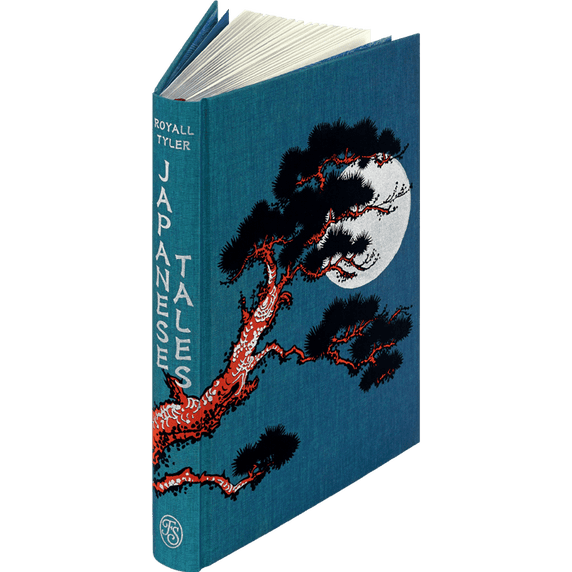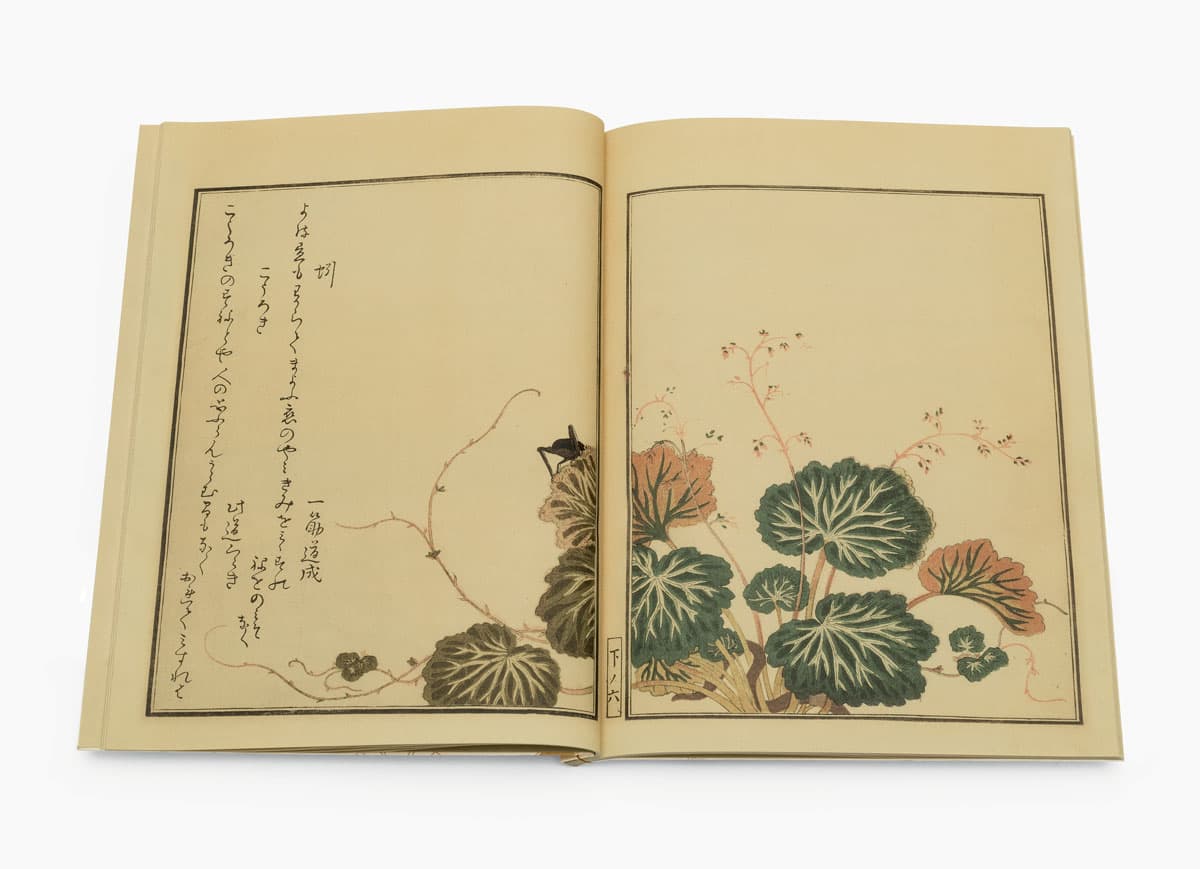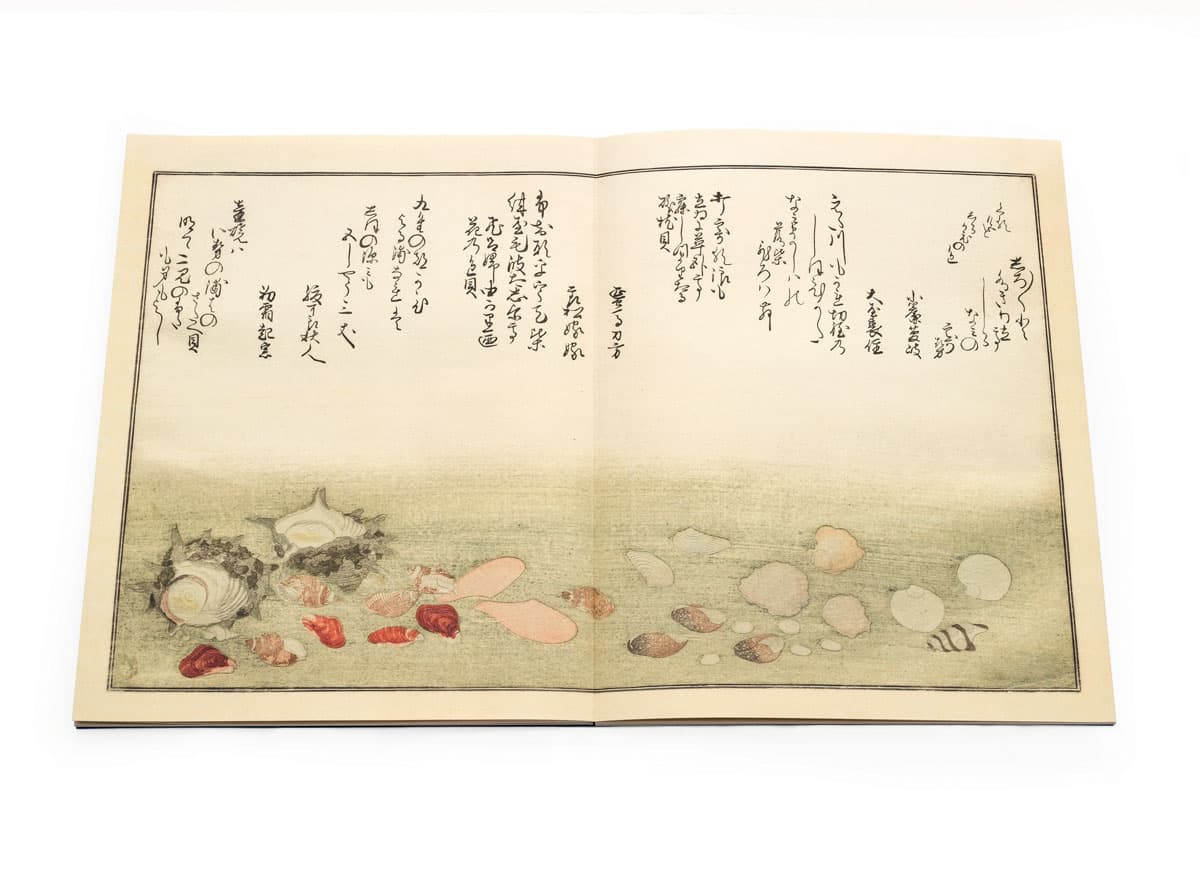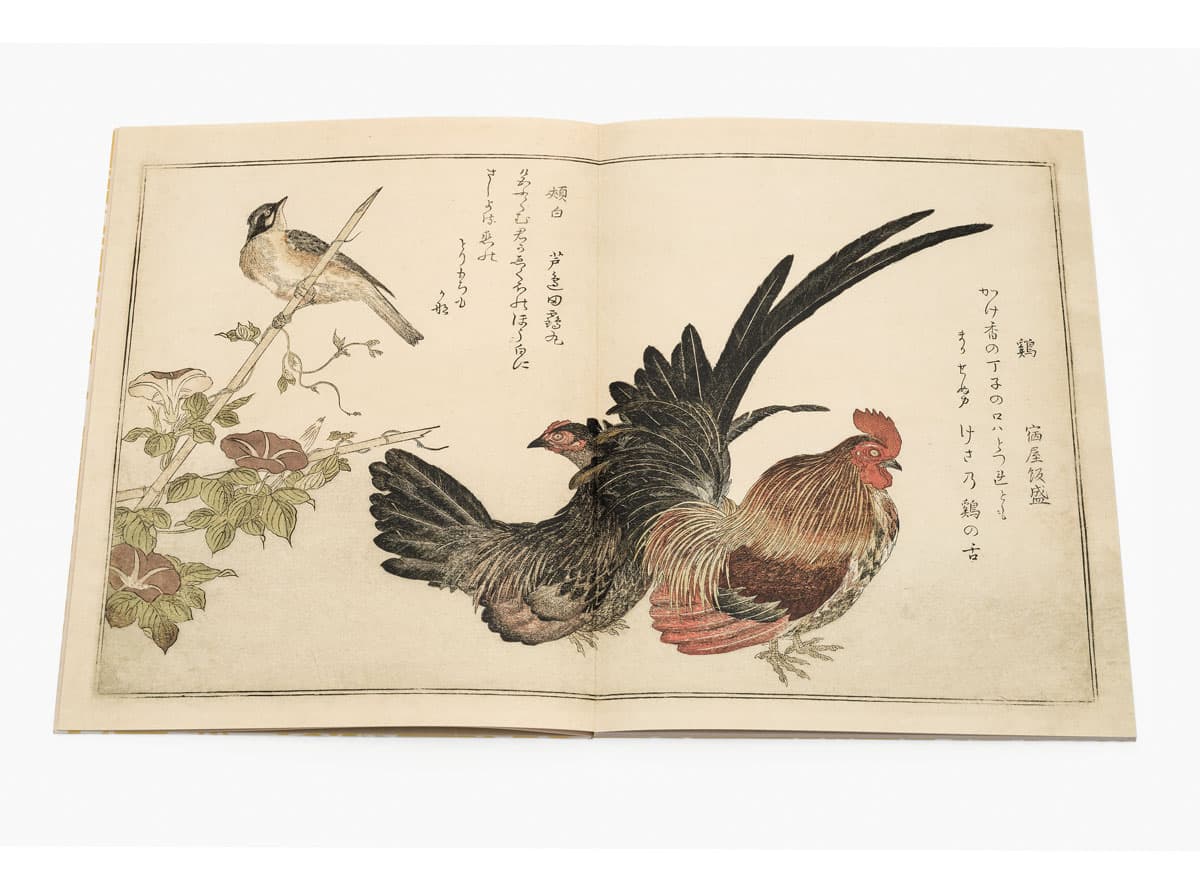
A treasury of Japanese folklore and wisdom, beautifully bound by Folio and fully illustrated by artist Yuko Shimizu.
Translated by John T. Carpenter
Limited to 500 numbered sets
Essays by John T. Carpenter, Alfred Haft and Alex Kerr
Five hand-crafted books of exquisite Japanese art and poetry in facsimile for the first time
Nominated in both the Best British Book and the Limited Edition and Fine Binding categories of the British Book Production and Design Awards
Kitagawa Utamaro’s Studies from Nature, rarely seen and never before reproduced in facsimile, are five superbly bound and illustrated books of insects, shells and birds. The elegant depictions of nature are paired with kyōka; playful, erudite and often erotic poems on the sentiments of love. Limited to just 500 hand-numbered sets, this remarkable publication includes a commentary volume with a full translation and newly commissioned essays on the poetry, the artist and the culture of the Floating World.
Facsimiles
Two volumes of The Book of Crawling Creatures Japanese sewn binding
Gifts of the Ebb Tide and two volumes of The Book of Myriad Birds concertina binding
All volumes bound in Twist paper printed with original designs redrawn by Neil Gower
Printed paper labels with titles in English and in Japanese script
Illustrations and poems printed on Papermilk paper
100 pages in total
10¾˝ x 8¼˝
Limitation certificate wrapped in Watermark Unryu White Japanese paper
Commentary
Bound in Twist paper blocked in gold
160 pages printed on Abbey Pure paper
Presentation box
Cloth-covered presentation box lined with paper printed to complement the bindings and tied with grosgrain ribbon
Paper label with title in English and in Japanese script
During Japan’s Edo period art and literature flourished and Kitagawa Utamaro (c.1754–1806) rose to fame as one of Japan’s most highly regarded artists and printmakers. Alongside his contemporaries Hiroshige and Hokusai, Utamaro was an acknowledged master of ukiyo-e, pictures of the Floating World.
Designed between 1788 and 1790 the Studies from Nature are amongst Utamaro’s earliest known works and brought together the artist and the era’s best writers, printers and bookbinders. The two-volume The Book of Crawling Creatures, the single-volume Gifts of the Ebb Tide and the two-volume The Book of Myriad Birds are considered the ne plus ultra of the colour woodblock printer’s art and the art of bookmaking of the period.
The Folio Society has printed from amongst the finest surviving first editions – luxury items in their own time and now treasures of the British Museum and the Fitzwilliam Museum – reproducing each element with absolute fidelity. These beautiful books are designed to be read in the traditional Japanese style from back cover to front, and from right to left across the page. In each, Utamaro’s elegant illustrations, as interesting to the naturalist as they are to lovers of art and poetry, are paired with kyōka: playful, erudite and often erotic poems on the sentiments of love, composed by some of the form’s most prominent poets.

I wander lost, unaware
if it’s night or day,
like an earthworm,
blind in love’s darkness
but always crying for you!
– Hitosuji no Michinari
Yoru hiru mo
wakarade mayou
koi no yami
kimi o mimizu no
ne o nomi zo naku
My lover must think
that I’m like the legs
of a cricket,
and that I can instantly
fold up my pent-up anger!
– Konomichi no Kuraki
Kōrogi no
sune to ya hito no
omou ran
uramu ma mo naku
orete misureba
The book opens with a charming description: a group of poets gathers to listen to ‘the insects that chirp in the fields’, whiling away the night composing love poems uttered in the voices of locusts, butterflies and lizards. The resulting verses follow, printed alongside 15 of Utamaro’s delicate designs in two volumes. Unlike the succeeding titles, these first books were bound, sewn at the spine, so that each illustration is divided in two. Together they feature two poems and two different species, elegantly portrayed in a natural setting.
Folio’s facsimile is based on the edition held at the British Museum that once belonged to 18th-century naturalist Joseph Banks, who may have brought it back to Europe as part of a cargo of the Dutch East India Company, the only foreigners who were allowed to trade in Japan at the time. Likely one of Banks’ prized possessions, Book One bears his name in two places.
The Book of Crawling Creatures features astonishing special effects, all reproduced in these facsimiles: fine gradations of muted pigment, embossing to produce part of an image through texture alone, and the use of varnish, originally mica, to emulate iridescent lustre on some insect wings.

The incoming waves,
cresting then crashing,
come to a rest in grasses
and fall into deep slumber
on ‘pillow’ shells by the sea.
– Ama no Matekata
Uchiyosuru
nami mo tachii ni
kutabirete
neshizumaritaru
iso makura-gai
Dyers who make patterns
of wisteria blossoms flee
as people in bare feet
gather ‘coloured’ shells
tinged like purple flowers.
– Fushimatsu no Kaka
Fuji-gata o
uteba konya mo
hadashi nite
hirou yukari no
hana no iro-gai
These poems, two of six on the page, refer to the shells in the centre of the illustration
Reproduced from the first edition held at the Fitzwilliam Museum, Cambridge, the second book is set around a loose narrative that begins with a group of poets combing for shells on a beach and ends with a shell-matching game. The 38 verses, ‘gathered together like a collection of seaweed and shells’, are the poets’ ‘souvenirs’ – light, emotive poems inspired by their outing, and the sake they have drunk throughout the day. This is the only one of the Studies to include illustrations of people; in the final image, a young girl carries a dog on her back, this is thought to refer to 1790 which was a dog year.
Six poems are transcribed over each of Utamaro’s shell portraits in this concertina-bound album, a form that allowed individual pictures to be displayed as a whole, and one that came with a higher cultural cachet.
Each shell is depicted with such precision that every species can be identified, allowing for the Latin names to be included alongside the generic Japanese in the commentary volume. Spectacular printing effects include embossing to suggest the natural concentric ridges on some shells, and varnish to evoke the wet sheen on others.

Though the mouth
of a sachet of cloves
can be sealed shut,
the tongue of the cockerel
cannot be stopped at dawn.
– Yadoya no Meshimori
Kakegō no
chōji no kuchi wa
tozuredomo
makasenu kesa no
niwatori no shita
Your dimples
like the ‘white-cheek’ bird
are so charming, I wish
I could use sticky birdlime
to capture your love.
– Ashibe no Tazumaru
Iro fukumu
kimi ga ekubo no
hōjirō ni
sashiyoru koi no
torimochi mogana
As the preface proclaims in the final title to be published, Utamaro next took up his brush to ‘capture the attitudes of flocking birds in brocade prints of the east’. Equally appealing to ornithologists and art lovers, Utamaro’s 15 illustrations each include two distinct species of bird and an array of botanically accurate representations of trees, plants and flowers. Like The Book of Crawling Creatures, the two-volume, concertina-bound The Book of Myriad Birds has been reproduced from a first edition held at the British Museum.
Like his crawling creatures and shells, Utamaro’s birds belong to the genre of works drawn from life, or shasei, and are astonishing in both their level of detail and lifelike charm. As in the previous volumes, superior printing techniques are used to full effect: tonal gradations give the birds their fluffy, rounded volume, and embossing lends texture to feathers and petals alike, further enhancing the woodblock printing.
Two poems accompany each of Utamaro’s illustrations. All composed on the theme of love, they are witty, tender and erotic by turns. As the preface notes, like the calls of the birds that inspired them, they ‘console the heart and delight the ear’.
John T. Carpenter, curator at The Metropolitan Museum of Art in New York, has written fascinating translations of all the poems, or kyōka, revised for this edition. The poetry is witty and erudite but also often surprisingly sensual. His accompanying notes reveal verses that are rich in wordplay and allusion to traditional waka (court poetry) and other East Asian classical literature as well as giving information about the flora and fauna depicted. The prefaces and postscripts for The Book of Crawling Creatures and The Book of Myriad Birds are by Timothy Clark and are most interesting, with the postscripts listing other books by the same publisher and the address of the bookseller from which they might be purchased.
Following the translations are three newly commissioned essays. The first, also by Carpenter, provides the perfect introduction to the period’s kyōka movement. He notes that the books ‘have achieved fame for their pictorial and technical brilliance, but the volumes should equally be recognised for their distinguished literary content’. Many of the most influential poetry masters of the day contributed kyōka verses using the form as a means of intellectual escape.
In the second essay, Alfred Haft, project curator in the Japanese Section of the Department of Asia at the British Museum, sets Utamaro’s images in the context of wider trends in Japanese art, explaining how the three titles ‘epitomise the informed, aesthetically refined and broad-minded culture of the Floating World’. Alex Kerr, author of Lost Japan and an expert on Japanese culture and art, provides the final piece considering the enigmatic allure of both Utamaro and his enchanting illustrations of insects, shells and birds.
Ten years ago, one of our editors visited an exhibition at the Fitzwilliam Museum in Cambridge that featured a selection of their most remarkable 18th-century Japanese woodblock prints and publications. At its centre was Kitagawa Utamaro’s Studies from Nature. The flawless illustrations, elegant bindings and exquisite calligraphy were instantly appealing and further enquiries followed. Though these five books were perfect candidates for a limited edition, it was obvious that creating faithful reproductions would be challenging.
Our production director gathered a team of paper makers, craft printers and specialist binders and the work began. After months of trials Smith Settle, a Yorkshire-based printer and hand-bindery, perfected the use of subtle embossing to reproduce the texture and intricate details of the shell ridges and bird feathers in the original books. Pureprint, a reprographics house based in East Sussex, then found a means of representing the mica sheen used to suggest iridescent insect wings and the natural sheen of wet shells. To replicate the first editions as closely as possible, all Utamaro’s illustrations have been printed on Papermilk paper which has the softness of that used originally as well as long milk fibres which give it exceptional strength.
The binding styles, both Japanese and concertina, have been faithfully reproduced by Smith Settle. The cover paper, Twist, was chosen for its texture and though the designs on the original books were somewhat faded and worn, award-winning artist Neil Gower has recreated them with great sensitivity. Each of the titles, as well as the set as a whole, features a printed paper label designed by Japanese calligrapher Kashuu. Various styles of Japanese script are used in the original books but, after carefully examining all the different characters, Kashuu adopted the Kai-sho style to unify the elements. The hand-numbered limitation certificate is wrapped in the softest Watermark Unryu White Japanese paper and this, with all six volumes, is presented in a single cloth-covered folding box, secured with grosgrain ribbon, and made by hand by G. Ryder & Co Ltd in Bletchley, Buckinghamshire. The design printed on the paper lining of the box refers to the cover of The Book of Crawling Creatures but is in dark blue and gold to complement the set.
Both the original books and the facsimiles are works of art and The Folio Society is delighted that the result of a long and complex collaboration is truly faithful replicas of such beautiful treasures.
